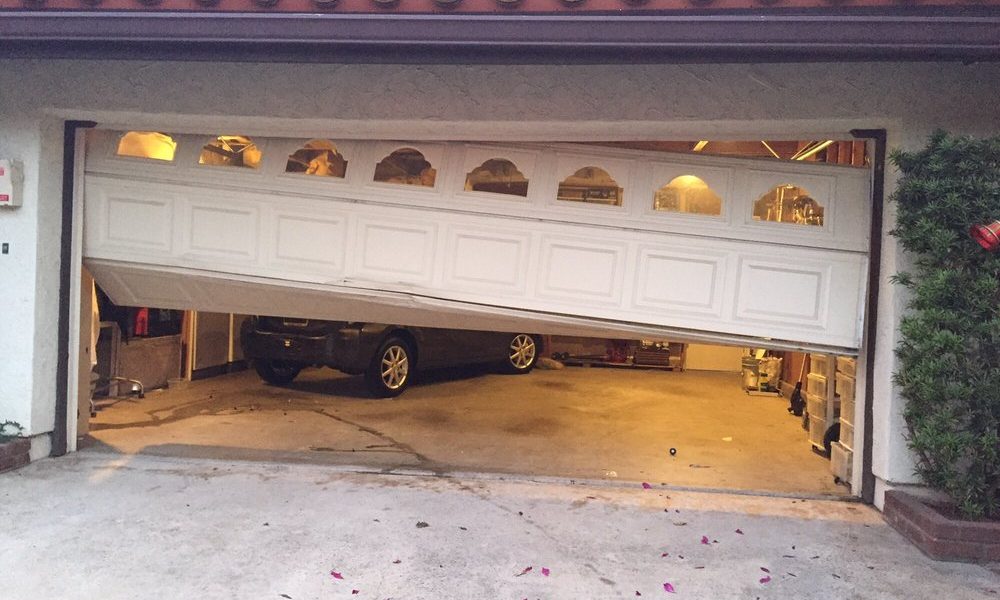Emergency Garage Door Repairs: What to Do Before the Pros Arrive – The opinions expressed by the author in this and all guest blogs are not necessarily those of Gainesville Restoration and Remodeling.

Emergency Garage Door Repairs: What to Do Before the Pros Arrive
You’re minding your own business, cruising in and out of your garage with your trusty garage door doing its thing. Life is good until, BAM! Your garage door decides to throw a tantrum.
When your garage goes on the fritz, and you are not ready to invest in a new garage door or garage door installation, panic sets in. But fear not! This guide will walk you through the steps to take before the professionals arrive. Remember, a little know-how can go a long way in preventing further damage and saving you from a hefty repair bill.
Assess the Situation
The first rule of Garage Club: assess the damage. Like a detective at a crime scene, take a step back and look at the big picture. Here’s what you need to consider before calling garage door service.
Ensure Safety
Safety should be your top priority. Before attempting any troubleshooting, disconnect the garage door opener to prevent accidental activation. Use vise grips to secure the door in place, ensuring it won’t unexpectedly come crashing down while you work.
Identify the Problem
Before the pros step in, try to get a handle on what’s happening with your garage door. Here’s how you can pinpoint the problem:
- Check for Stuck Points: Examine if your garage door is refusing to budge or stuck in a particular position. This could help diagnose issues related to tracks or obstructions.
- Listen for Strange Noises: Pay attention to the sounds your garage door makes. Are there unusual clanks, bangs, or creaks? These sounds can be indicative of potential problems with various components.
- Spot Mid-Air Pauses: If the garage door stops halfway during its operation, take note of the specific point. This detail can guide professionals in identifying potential disruptions in the tracks or problems with the door’s balance.
- Watch for Sensor Hiccups: In cases where the garage door behaves erratically, stopping or reversing without warning, consider the photo-eye sensors. Documenting these instances helps technicians address potential sensor misalignments or obstructions.
- Check Response Time: Evaluate how quickly your garage door responds to commands. If there’s a delay, inspect the remote batteries and watch for interference from nearby electronics. This information assists in identifying issues with the control system.
Document the Problem
In the midst of a garage door emergency, documenting the details of the issue is a crucial step that often proves invaluable when communicating with professionals. By taking note of specific details, homeowners can provide accurate information, aiding technicians in diagnosing and efficiently resolving the problem.
- Take a Good Look: Check out what’s happening with your garage door. Is it acting weird or making funky noises? Note down exactly what’s going on. Make a quick note of when all this started. The more info, the better!
- Inspect the Basics: Give your garage door a once-over. Look for anything that seems off – like parts that look wonky, misaligned tracks, or anything that seems worn out. Pay attention to how the tracks, rollers, hinges, and springs are holding up.
- Listen Up: Tune in to the sounds your garage door is making. What kind of noise is it? Creaking, grinding, or maybe it’s just being a bit dramatic? Write it down so you can share it with the experts.
- History Check: Has anything been fixed or tweaked recently? Let the experts know about any recent DIY adventures or professional help you’ve called in. It helps them connect the dots.
By taking a moment to observe and note down these specific details, you’re essentially creating a helpful roadmap for the professionals. This extra information can significantly expedite the troubleshooting and repair process when the experts arrive.
What Not to Do
While waiting for professional assistance, it’s crucial to steer clear of actions that may worsen the situation or compromise safety. Here’s a list of things you should not do:
- Forceful Maneuvers: Resist the urge to forcefully open or close a stuck garage door. Forcing it may cause further damage to the tracks, rollers, or motor.
- DIY Overhaul: Avoid attempting major repairs or disassembly if you lack the expertise. Garage doors are complex systems and DIY efforts could lead to more problems.
- Tampering with Sensors: Refrain from tampering with the photo-eye sensors. Professionals best address misalignment or obstruction issues to ensure proper functionality.
- Excessive Lubrication: Avoid over-lubricating moving parts without professional guidance. Applying the wrong type or excessive lubrication can attract debris, causing more harm than good.
- Delaying Professional Help: Don’t procrastinate in seeking professional assistance. Delaying repairs might lead to further damage, resulting in higher repair costs.
Conclusion
Facing a garage door emergency can be daunting, but with the right steps, you can mitigate damage and ensure a smoother repair process. Remember to prioritize safety, explore DIY fixes cautiously, and, when in doubt, call in a garage door repair service. By taking preventive measures, you can reduce the likelihood of future emergencies and keep your garage door functioning smoothly.



